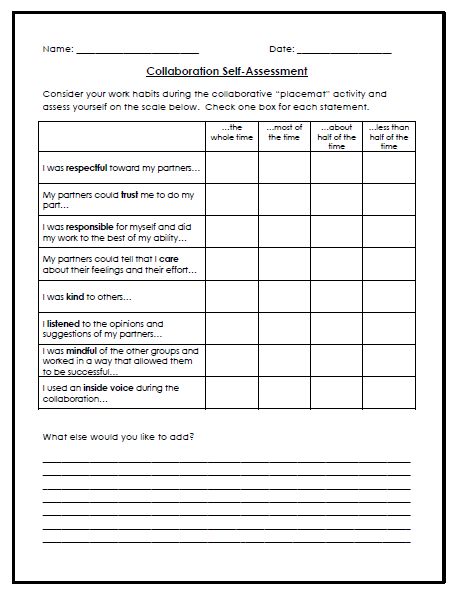I have been working closely with the literacy support teacher at my school recently. She and I have been co-teaching a Grade 8 Social Studies class and today I'd like to share an activity that she introduced me to: Collaborative Place Mats. This technique is especially helpful at the beginning of a project or inquiry to help groups start to brainstorm about their big idea, topic, or question.
Before we began the activity, we talked as a class about what behaviours we wanted to follow as we worked in groups. Students offered ideas, and they were recorded on chart paper.
From their criteria, I created a self-assessment checklist for the students to use as a reflection after the activity.
Once we had established the guidelines, we explained the place mat activity. Here's how it works:
I used this technique in a Middle School Social Studies class, but I really believe it could be differentiated for any grade level in any subject area.
Have you used this brainstorming technique (or something like it) before? Let me know what worked/didn't work for you in the comments below.
Before we began the activity, we talked as a class about what behaviours we wanted to follow as we worked in groups. Students offered ideas, and they were recorded on chart paper.
From their criteria, I created a self-assessment checklist for the students to use as a reflection after the activity.
Once we had established the guidelines, we explained the place mat activity. Here's how it works:
- Each table received a piece of chart paper with our project question in the middle. In this case, the question was "How would you provide for people in a community."
- Each group separated the chart paper into equal sections, one for every member of the group, then we asked the students to write their names in their sections.
- Students had 2 minutes of silent writing time to think on their own and write their ideas in their section of the place mat.
- After the 2 minutes were up, the students took turns explaining what they wrote down to the other members of their group. Each student got 1 minute to explain while the other students listened silently.
- After every student in the group shared his or her ideas, then the other students could ask questions. We gave the groups 5 more minutes for questions and discussion, encouraging them to write more if they had more ideas.
- We then asked each group to choose 3 or 4 ideas to share out to the whole class. As the groups were sharing out, each student was encouraged to continue writing down ideas they liked on their own place mat.
- After the groups each shared out, the students had a chance to walk from table to table to see and read the other groups' place mats.
I used this technique in a Middle School Social Studies class, but I really believe it could be differentiated for any grade level in any subject area.
Have you used this brainstorming technique (or something like it) before? Let me know what worked/didn't work for you in the comments below.
Looking for more great tips and ideas for middle school? Subscribe to my email list and receive an exclusive FREE sub plans resource. It includes plans for math, ELA, science, social studies, and Core French. Click here to subscribe.







What a fantastic idea. I am going to try this in my upper-level French class where we usually do small group discussions, but sometimes only two of the four people participate. This will help ensure accountability for each person and provide a nice formative assessment for me. I especially like the gallery walkthrough in the end.
ReplyDeleteThis idea is great!! I will be using it with my changes in teaching this year!
ReplyDeleteThank you for sharing!!!